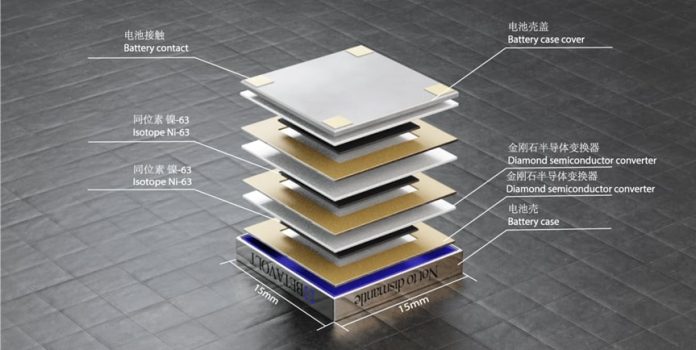Betavolt Technology, a Beijing based company has announced miniaturization of nuclear battery using Ni-63 radioisotope and diamond semiconductor (fourth generation semiconductor) module.
Nuclear battery (known variously as atomic battery or radioisotope battery or radioisotope generator or radiation-voltaic battery or Betavoltaic battery) consists of a beta-emitting radioisotope and a semiconductor. It generates electricity through the semiconductor transition of beta particles (or electrons) emitted by the radioisotope nickel-63. The Betavoltaic battery (i.e. nuclear battery that uses beta particle emissions from Ni-63 isotope for power generation) technology is available for over five decades since first discovery in 1913 and is routinely used in space sector to power spacecraft payloads. Its energy density is very high but power output is very low. The key advantage of nuclear battery is long-lasting, continuous power supply for five decades.
Table: Types of battery
| Chemical battery converts chemical energy stored in the device to electricity. It is basically electrochemical cell consisting of three basic elements – a cathode, an anode, and an electrolyte. Can be recharged, different metals and electrolytes can be used e.g., batteries Alkaline, Nickel Metal Hydride (NiMH), and Lithium Ion. It has low power density but high-power output. |
| Fuel battery converts the chemical energy of a fuel (often hydrogen) and an oxidizing agent (often oxygen) into electricity. If hydrogen is the fuel, the only products are electricity, water, and heat. |
| Nuclear battery (also known as Atomic battery or Radioisotope battery or radioisotope generator or Radiation-voltaic batteries) converts radioisotope energy from the decay of a radioactive isotopes to generate electricity. Nuclear battery has high energy density and are long lasting but has the disadvantage of low power output. Betavoltaic battery: a nuclear battery that uses beta emissions (electrons) from the radioisotope. X-ray-voltaic battery uses X-ray radiation emitted by the radioisotope. |
Betavolt Technology’s real innovation is development of a single-crystal, fourth-generation diamond semiconductor of 10 microns thickness. Diamond is more suitable for use due to its large band gap of over 5eV and radiation resistance. High-efficiency diamond converters are the key to manufacturing nuclear batteries. Radioisotope Ni-63 sheets of 2-micron thickness are placed between two diamond semiconductor converters. The battery is modular consisting of several independent units. The battery’s power is 100 microwatts, the voltage is 3V and the dimension is 15 X 15 X 5 mm3.
The American firm Widetronix’s betavoltaic battery uses silicon carbide (SiC) semiconductor.
BV100, the miniature nuclear battery, developed by Betavolt Technology is currently in pilot stage and is likely enter mass production stage in near future. This could find use in powering AI equipment, medical equipment, MEMS systems, advanced sensors, small drones and micro-robots.
Such miniaturised micro power sources are need of the hour in view of advances in nanotechnology and electronics.
Betavolt Technology plans to launch a battery with a power of 1 watt in 2025.
On related note, a recent study reports a novel X-ray radiation-voltaic (X-ray-voltaic) battery with up to three times higher power output than that of state-of-the-art betavoltaics.
***
References:
- Betavolt Technology 2024. News – Betavolt successfully develops atomic energy battery for civilian use. Posted 8 January 2024. Available at https://www.betavolt.tech/359485-359485_645066.html
- Zhao Y., et al 2024. New member of micro power sources for extreme environmental explorations: X-ray-voltaic batteries. Applied Energy. Volume 353, Part B, 1 January 2024, 122103/ DOI: https://doi.org/10.1016/j.apenergy.2023.122103
***






































